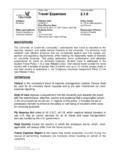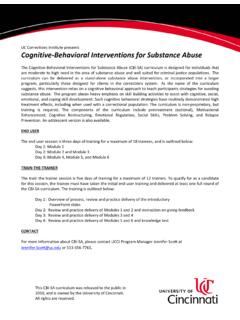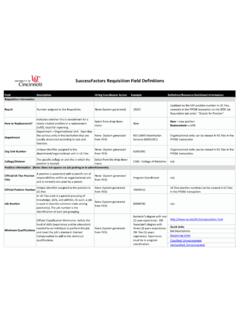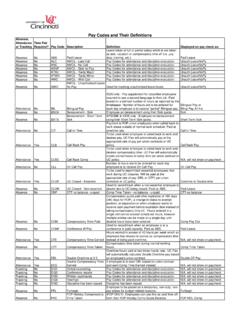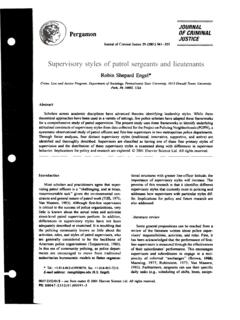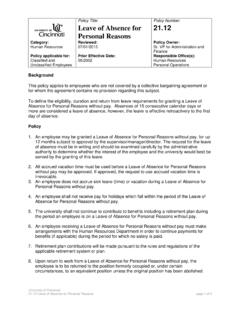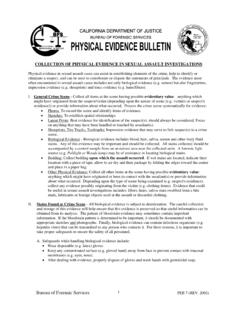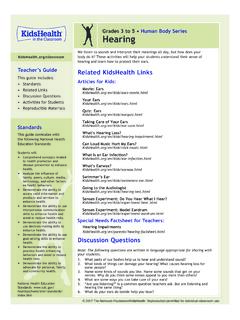Transcription of INTEGUMENTARY SYSTEM - University of Cincinnati
1 INTEGUMENTARY SYSTEM . COMPILED BY HOWIE BAUM. THE SKIN. This extraordinary organ It is the body's first line SYSTEM : of defense against bacteria, viruses, and Protects the internal other pathogens. structures of the body from damage It helps to provide protection from harmful Prevents dehydration ultraviolet radiation. Stores fat The skin is a sensory organ with receptors for Produces vitamins and detecting heat and cold, hormones. touch, pressure, and pain. Helps to maintain The natural secretion of homeostasis within the sebum from the millions body by assisting with the of sebaceous glands, each regulation of body associated with a hair temperature and water follicle, is slightly oily and balance. furnishes the skin with partially water-repellent and antibiotic qualities.
2 TOGETHER, SKIN, HAIR, AND NAILS ARE KNOWN AS THE. INTEGUMENTARY SYSTEM . The skin is the largest organ in the body, weighing 6 9 pounds and with a surface area of almost 21 square feet. Its thickness varies from about 1/50 inch on delicate areas such as the eyelids, to 1/5. inch or more on areas of wear and tear, such as the soles of the feet. Few body parts renew as rapidly as the skin. Every month the outer layer of epidermis is completely replaced, at a rate of 30,000. flake-like dead cells every minute. The journey from epidermal base to surface takes about four weeks, and a typical person sheds more than 1 pound of skin every year !! Dead skin cells combine with other particles to create household dust. The average home in the United States collects 40 pounds of dust each year !
3 ! Skin has two main structural layers. The outer Epidermis is chiefly protective, and the underlying Dermis contains many different tissues with varied functions. The Dermis contains thousands of microsensors that enable the sense of touch, as well as sweat glands and adjustable blood vessels that contribute to body temperature regulation. Under the dermis is a layer, sometimes regarded as part of the skin, called the Hypodermis and is made of subcutaneous fat. This layer acts as a buffer and provides extra thermal insulation against extreme heat and cold. Dermatomes A dermatome is a region or zone of skin supplied by the dorsal (rear, sensory) nerve roots of one pair of spinal nerves. The nerve branches carry sensory information about touch, pressure, heat, cold, and pain from the skin microsensors within the zone, along the sensory nerve fibers of the branches of the spinal nerve, to the spinal nerve root and then into the spinal cord.
4 A skin map delineates these skin zones, or dermatomes. In real life, the distribution of nerve roots, and so of sensations, overlaps slightly. A patch of skin about the size of a fingernail contains 5,000,000 (5 million). microscopic cells of at least a dozen main kinds: 100 sweat glands and their pores 1,000 touch sensors 100-plus hairs with their sebaceous glands Up to 3-1/3 feet of tiny blood vessels and about 1-2/3 feet of nerve fibers. Meissner's corpuscle Encapsulated nerve ending in the skin's upper dermis, especially on the palms, soles, lips, eyelids, external genitals, and nipples, respond to light pressure. Merkels's disc Receptors, usually in the upper dermis or lower epidermis, especially in non-hairy areas. They sense faint touch and light pressure.
5 Ruffini corpuscle Encapsulated receptor in the skin and deeper tissue that reacts to continuous touch and pressure. In joint capsules, it responds to rotational movement. Pacinian corpuscle Large, covered receptor located deep in the dermis, as well as in the bladder wall, and near joints and muscles. It senses stronger, more sustained pressure. HOW A SKIN INJURY GETS. REPAIRED BY THE BODY. Injury 1) The wound breaks open cells and releases their contents. These components attract various defense and repair cells. 2) Clotting Blood seeps from the vessel and forms a clot. Fibroblasts multiply and migrate to the damaged area as do white cells called neutrophils, which ingest cell debris and foreign matter, such as dirt and germs.
6 3) Plugging Fibroblasts produce a plug of fibrous tissue within the clot, which contracts and shrinks. New tissue begins to form beneath. The clot gradually hardens and expels fluid to become a scab, as the tissues heal beneath. 4) Scabbing The plug hardens and dries into a scab, which eventually detaches. A scar may remain but usually fades with time. Ultraviolet defenses The Sun's rays include a spectrum of color wavelengths, including infrared or IR rays (the warming component) and ultraviolet, UV, rays. Both UV-A and UV-B wavelengths are invisible to human eyes, but exposure to the latter, in particular, is linked to forms of skin cancer. Skin's self-defense is its dark coloring substance, or pigment, melanin. This forms a screen in the upper epidermis that shields the actively multiplying cells in the base of the epidermis.
7 Melanin production Melanocytes are melanin-producing cells in the base of the epidermis. They make parcels of melanin granules, melanosomes, which pass into surrounding cells. GETTING VITAMIN D FROM SUNLIGHT AND FOODS. Our skin naturally contains a precursor to vitamin D. When the sun's ultraviolet rays touch the skin, they convert the precursor to a molecule called vitamin D3, which then follows a metabolic pathway through the liver and finally to the kidneys, where it's converted into a molecule called calcitriol. That's the good stuff the active form. (Vitamin D obtained from food or supplements must also follow that metabolic pathway to become active.). Vitamin D is essential to healthy bones, because it helps you absorb calcium, which strengthens your skeleton.
8 Without the vitamin, you could develop brittle bones, increasing the chance of getting osteoporosis when you're older. Children with insufficient vitamin D can develop soft bones, putting them at risk for rickets. Inadequate amounts of vitamin D can also lead to a weakened immune SYSTEM . HAIR GROWTH. Hairs are rods of dead, flattened cells filled with keratin and have a mainly protective role. The hair's root, or bulb, is buried in a pit, the follicle. As extra cells add to the root, the hair lengthens from its base. Different kinds of hairs grow at varying rates, with scalp hairs lengthening about 1/100 inch, each day. However, hair does not grow continuously. After three to four years, the follicle goes into a rest phase and the hair may detach at its base.
9 Rest phase - The hair grows to its maximum Three to six months later, the follicle activates length. Activity in the follicle stops and the hair again and begins to produce a new hair. dies. Growth phase A new hair sprouts at the base of the follicle. As it grows, the dead hair is shed. Temperature regulation - One of the skin's functions is to contribute to thermoregulation maintenance of a constant body temperature. It does this in three main ways: Widening and narrowing of blood vessels Sweating Hair adjustment. If the body becomes hot, blood vessels in the dermis widen (vasodilate) to allow extra blood flow so more warmth can be lost from the surface. The skin may look flushed, and sweat oozes from sweat glands and evaporates, drawing away body heat.
10 If the body is cold, the peripheral blood vessels narrow (vasoconstrict) to minimize heat loss, and sweating is Feeling cold - Tiny body hairs, raised by contraction reduced. of the erector pili muscles, create small mounds known as goose pimples at their bases. Tiny body hairs are pulled upright by the erector pili muscles to trap air as an insulating layer. The peripheral blood vessels constrict, and sweat glands reduce their activity. Feeling hot Tiny body hairs lie flatter as the erector pili muscles relax, and the small mounds at their bases disappear. Dermal blood vessels dilate, increasing blood flow, and the sweat glands raise their output of sweat. Eyebrows and eyelashes Scalp hair The arch of relatively coarse, fast-growing head hairs help to keep rainwater eyebrow hairs helps to divert sweat or from the scalp, absorb or deflect some rainwater on the forehead that might trickle of the energy in knocks and blows, into the eyes.
